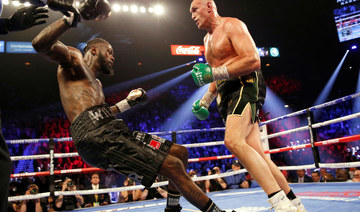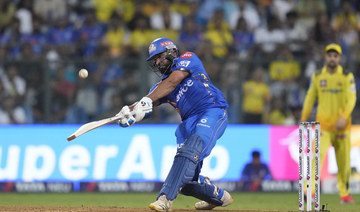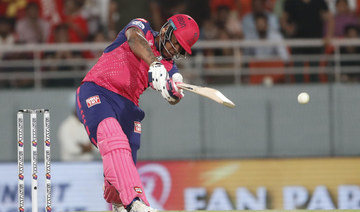LAS VEGAS: Tyson Fury got up from two fourth-round knockdowns and stopped Deontay Wilder in the 11th round Saturday night, retaining his WBC title in a thrilling conclusion to a superlative heavyweight trilogy.
Fury (31-0-1, 22 KOs) finished Wilder for the second straight time in their three bouts, but only after a wild back-and-forth evening featuring five combined knockdowns.
“It was a great fight,” Fury said. “It was worthy of any trilogy in the history of the sport. He’s a top fighter, and he gave me a real (test) tonight.”
Wilder was knocked down in the third round and appeared to be on his way out, but he improbably rallied to knock down Fury twice in the final minutes of the fourth.
Wilder (42-2-1) absorbed enormous punishment and appeared to be physically drained for much of the bout, but the veteran champion showed his toughness while still throwing power shots on weary legs.
Fury knocked down Wilder again with a concussive right hand midway through the 10th, but Wilder stunned Fury in the final seconds of the round.
Fury finally finished it in the 11th, sending Wilder face-first to the canvas with a chopping right hand fired from high in the air. Fury climbed onto the ropes in weary celebration before a frenzied crowd of 15,820 at T-Mobile Arena on the south end of the Las Vegas Strip.
“Don’t ever doubt me when the chips are down,” Fury said. “I can always deliver.”
Fury then broke into a rendition of “Walking in Memphis,” in keeping with his post-fight tradition of serenading his crowds.
The fight likely concluded one of the most memorable rivalries in recent boxing history, a trilogy featuring nine combined knockdowns and two remarkable displays of pugilistic tenacity. A trilogy is a rarity in the fractured modern sport, but Fury and Wilder brought out the best in each other through a series spanning nearly three calendar years.
They met first in late 2018 in downtown Los Angeles, where Wilder knocked down Fury twice in the late rounds of an excellent fight. The second knockdown in the 12th round left Fury flat on his back and motionless while Wilder celebrated, but Fury improbably rose and reached the bell in a bout judged a split draw.
The second bout was in Las Vegas in February 2020, and Fury’s dominance was clear. The British champ battered Wilder until the seventh round, when Wilder’s corner threw in the towel on a one-sided victory and Fury claimed Wilder’s WBC title belt.
In this climactic third meeting, Wilder opened the first round with a strong jab and a good game plan, but appeared to tire early when he didn’t hurt Fury early.
In the final minute of the third, Fury stunned Wilder with a shot and then escaped a clinch to land a two-punch combination that put Wilder down to his knees. Fury battered Wilder again with the crowd on its feet, but Wilder made it to the bell.
Fury appeared to be in control until late in the fourth, when Wilder landed a powerful right hand squarely to the top of Fury’s head. Fury staggered and eventually fell to the canvas, only to get up and then be put down again moments later amid the crowd’s stunned roars.
Fury made it to the fourth-round bell, and both fighters landed impossibly big shots without a knockdown in the fifth and sixth. Fury hurt Wilder in the seventh with a series of punches that sent Wilder sprawling back against the ropes.
Fury hurt a visibly exhausted Wilder again in the eighth with two huge shots, and the ringside doctor examined Wilder before allowing the fight to continue into the ninth.
Fury’s devastating right hand swept Wilder’s legs out from under him in the 10th, but Wilder finished the round, even hurting Fury late.
It ended with one more right hand from close range. Wilder reached for the ropes on his way down, but landed facedown with his eyes glassy.
The bout was another loss for Wilder, but a validation of the former US Olympian’s impressive toughness, as well as his determination to get this third fight even after the one-sided nature of their second meeting.
Last year, Wilder handled his first defeat since the 2008 Beijing Olympics in bizarre fashion. He fired Mark Breland, his longtime trainer who threw in the towel, and then accused him of spiking his water bottle with a muscle relaxant. Wilder also claimed Fury had illegal gloves, among a litany of far-fetched claims that left Fury — no stranger to ridiculous behavior himself — ridiculing Wilder for his lack of professionalism.
“I beat him three times,” Fury said after the finale. “I tried to show him respect, and he wouldn’t give it back.”
But Wilder also exercised the rematch clause in his contract to reclaim his belt, and an arbitrator ruled in his favor after Fury attempted to book a showdown with fellow British heavyweight Anthony Joshua. Fury resignedly agreed to complete the trilogy, but made it clear he expected to stop Wilder again.
It happened, but only after much more drama than even Fury could have imagined.
Tyson Fury stops Deontay Wilder in 11th in another heavyweight thriller
https://arab.news/ywfxq
Tyson Fury stops Deontay Wilder in 11th in another heavyweight thriller
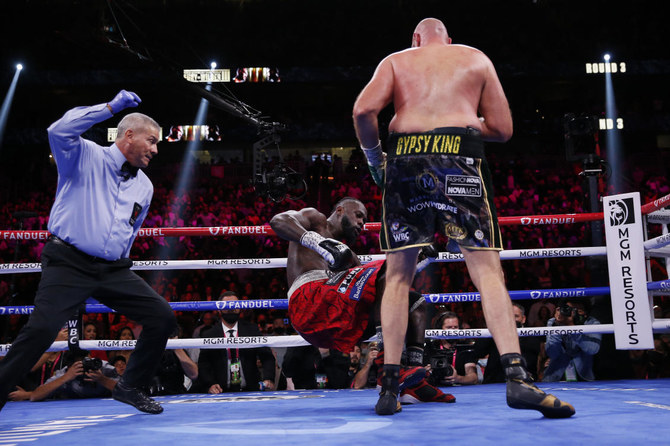
- Fury finishes Wilder for the second straight time in their three bouts
- Fight likely concluded one of the most memorable rivalries in recent boxing history
Mumbai Indians survive Ashutosh Sharma scare to beat Punjab Kings
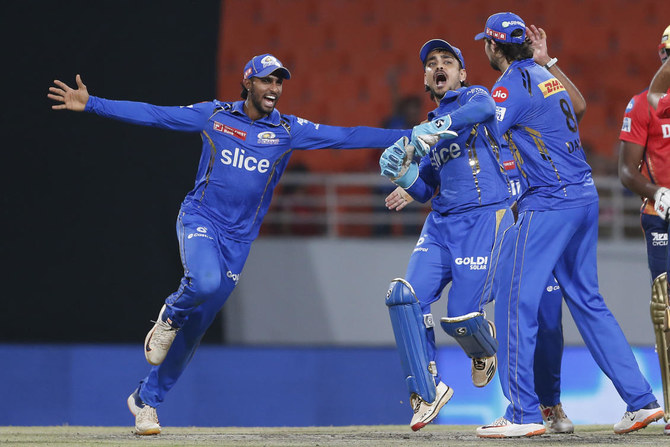
- Suryakumar Yadav hit an impressive 78 runs off 53 balls to help Mumbai Indians post a solid 192-7
- Sharma hit an explosive 61 runs off 28 balls for the Punjab Kings, but it was not enough to carry the day
MULLANPUR, India: Mumbai Indians managed to fend off a valiant effort by Punjab Kings batsman Ashutosh Sharma to win by nine runs in a fiercely fought IPL thriller on Thursday.
Invited to bat first, Mumbai Indians started off on a decent note. After losing only two wickets in the first 12 overs, Suryakumar Yadav went on to smash an impressive 78 runs off 53 balls to help the team post a solid 192-7.
The second innings began on a disastrous note for the Punjab Kings, with fast bowler Gerald Coetzee and Indian pacer Japsrit Bumrah striking quick to leave them reeling at 14-3 at the end of the second over.
Sharma eventually managed to help rebuild the innings with an explosive 61 runs off 28 balls, aided ably by Shashank Singh (41) and Harpreet Brar (21), but it was ultimately not enough to carry them through the day.
Punjab Kings acting captain Sam Curran said it was “heart-breaking” for his team to take it close and still lose.
“This team loves a close game. Got well to get close, thanks to Ashutosh... Hopefully we can win the close ones and get the momentum,” Curran added.
Mumbai openers Ishan Kishan and Rohit Sharma kicked off the first innings with an 18 run partnership before Kishan, who hit eight runs off eight balls, fell in the third over leaving the team at 18-1.
Sharma, who scored a 25-ball 36, built another partnership with Suryakumar Yadav before falling in the 12th over. Yadav went on to smash 78 runs off 53 balls before being dismissed in the 17th over.
Young Tilak Varma went on to rack up a solid 18-ball 34, with the assistance of cameos from Hardik Pandya (10) and Tim David (14), to help Mumbai wrap up the first innings at 192-7.
The game seemed in the bag in the early portion of the second innings, partly due to sharp bowling by Coetzee and Bumrah, who took three wickets each.
When the glimmer of hope given by Sharma was extinguished, Kagiso Rabada put up a last-ditch attempt with eight runs off three balls but ultimately ended up falling in the last over.
“What a game. We started really well. Cricket’s a funny game. We thought we had it, they battled really well. Then it was like a see-saw,” said Coetzee.
Li and Hend one back of Catlin while Moroccans Lguirati and Raouzi make cut at 2024 Saudi Open

- John Catlin birdied the 18th to remain at the top of the 2024 Saudi Open presented by PIF leaderboard
- Moroccans Ayoub Lgiurati and Othman Raouzi made the cut as Saudi amateur Khalid Walid Attieh missed by one stroke
RIYADH: Li Haotong and Scott Hend made the most of the calm morning conditions to head into the weekend one shot behind pacesetter John Catlin, who leads on 10-under-par after day two of the 2024 Saudi Open presented by PIF.
Catlin birdied the 18th hole as the sun set on a warm day at Riyadh Golf Club to ensure he heads into Friday ahead of Chinese star and DP World Tour member Li, who shot a scintillating 65, and Australian Hend. Steve Lewton’s 64 was the best round of the day and sees him in third place alongside David Puig, who finished his round with a triple bogey on the ninth hole.
Amateur Khalid Walid Attieh looked set to make history as the first Saudi player to make the cut since the tournament was elevated to the Asian Tour, however three bogeys on the back nine saw him miss out by one, with a putt just sliding by at the last.
Moroccan golfers Ayoub Lguirati and Othman Raouzi, who were two of the golfers given special invites to the tournament as part of Golf Saudi’s strategic partnership with the Arab Golf Federation, finished on one-under-par and even par respectively to extend their participation.
Lguirati said: “It was a positive day for me with only one bogey and one birdie. I stuck to my strategy all day and ended with a good result in a tough competition. I am very happy to have made the cut in this tournament and to play over the next two days.
“I usually play on the second tier Asian Development Tour but with the help of the Royal Moroccan Golf Association and Golf Saudi I have been able to reach this level and I continue improving.”
Meanwhile, Li is excited to challenge for the 2024 Saudi Open presented by PIF trophy as he looks to put some recent poor form behind him. Four birdies in five holes on his back nine catapulted him up the leaderboard.
Li said: “I played really well and wasted some chances. The course played a lot easier compared to yesterday, because of no wind and easier pin positions.
“I am still struggling a little bit off the tee, but except for that everything’s pretty solid overall. I am here to try and get the job done and get the trophy! So hopefully I have a hot start tomorrow.”
Li will play alongside Hend and Catlin on Friday, but will be wary of Asian Tour Order of Merit leader Puig in the penultimate group, who won the PIF Moment of the Day for a stunning front nine of 29, which included five birdies and an eagle in his first six holes.
Rain wipes out first Pakistan-New Zealand T20 after just two balls
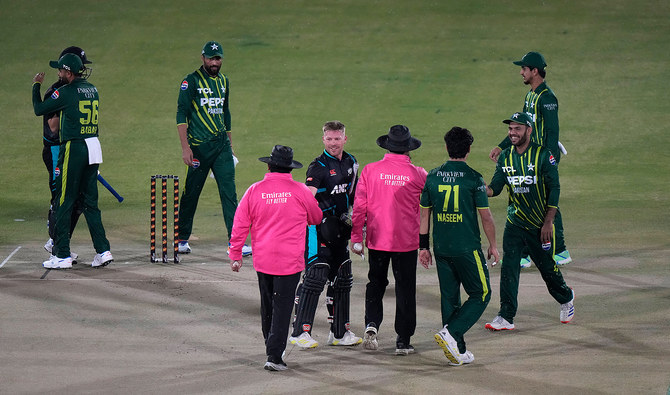
- Fast bowler Mohammad Amir returned to international cricket after nearly four years
- Having come out of retirement last month, Amir’s participation was limited to just fielding
RAWALPINDI: Heavy rain caused the first Twenty20 international between Pakistan and New Zealand to be abandoned after just two deliveries in Rawalpindi on Thursday.
New Zealand skipper Michael Bracewell won the toss, which had also been delayed by 30 minutes, and opted to bat but no action was possible for two-and-a-half hours.
Umpires Ahsan Raza and Aleem Dar then announced a five-over-a-side game at 10:10 local time (9:10 GMT).
Pakistan paceman Shaheen Shah Afridi conceded two leg-byes to debutant Tim Robinson off the first ball before bowling the batsman with a sharp delivery off the next.
But as soon as the Pakistan fielders started celebrating the wicket, the rain returned to force an abandonment.
Fast bowler Mohammad Amir returned to international cricket after nearly four years, having come out of retirement last month, but his participation was limited to just fielding.
The 32-year-old retired in December 2020 after being dropped from the side but changed his mind last month and decided to restart his career, which had already been stalled by a match-fixing ban in 2010.
Pakistan handed T20I caps to batsman Usman Khan, spinner Abrar Ahmed and all-rounder Muhammad Irfan Khan, while Robinson debuted for New Zealand.
The remaining matches are in Rawalpindi on April 20 and 21 and in Lahore on April 25 and 27.
The series gives a chance to both teams to test their bench strength ahead of the Twenty20 World Cup to be held in June in the United States and the West Indies.
New Zealand are without nine key players, including skipper Kane Williamson, who are playing in the ongoing Indian Premier League.
Juventus ordered to pay Ronaldo $10.4 million in back salary

- The five-time Ballon d’Or winner was the world’s highest-paid sportsman in 2023, with $136 million, including $46 million in wages
Rome: Juventus must pay Portuguese star Cristiano Ronaldo 9.7 million euros ($10.4 million) in back wages for the 2020-21 season, the Italian courts announced on Wednesday.
The Court of Arbitration, to which Ronaldo appealed, “orders Juventus Turin to pay the sum of 9,774,166.66 euros,” plus interest and procedural costs, it stated in its decision.
The sum equates to the difference between the salary actually received by Ronaldo and that which he should have received after tax and other deductions.
Ronaldo, who spent three seasons in Italy with Juventus (2018-21) before joining Manchester United (2021-22) and then the Saudi club Al Nassr, was claiming 19.5 million euros but the arbitration panel reduced that by 50 percent.
Contacted by AFP, Juventus declined to comment, but said it would be issuing a statement “shortly.”
According to the rankings drawn up by the American business magazine Forbes, the five-time Ballon d’Or winner was the world’s highest-paid sportsman in 2023, with $136 million, including $46 million in wages.
Juventus, who are listed on the stock exchange, recorded losses of 123.7 million euros in the 2022-23 financial year, which ran to the end of June, it announced in October.
No provision has been made in the accounts of Italian football’s most successful club, currently third in Serie A, for the payment of this wages backlog.
Marketing as much behind expansion of Asia Cup as merit
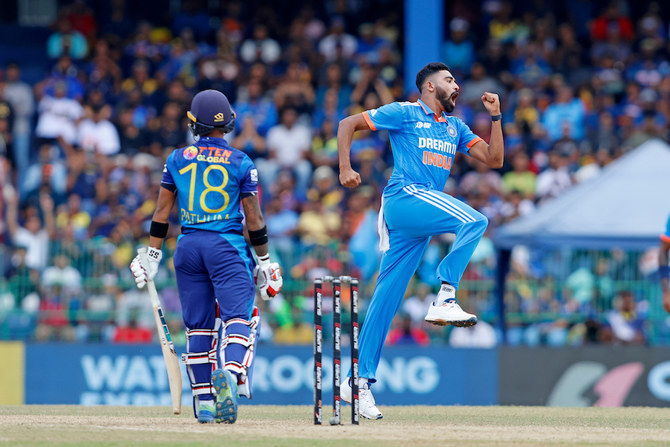
- Non-cricket fans may struggle to comprehend the links between the Asia Challenger Cup, the Asia Premier League and the Asia Cup
MUSCAT: Even to cricket aficionados — sometimes referred to as badgers — the various ways teams can qualify for the world’s major tournaments might appear opaque.
As may the term “badger”. Badgers are known for their tenacity, focus and persistence, qualities which can apply to those who dedicate chunks of their life to the game, its history, statistics, spectating, discussion and administration. This is not a complete list, but it provides a flavor.
A test case for tournament opaqueness is the Asia Cup. Non-badgers can be forgiven if they fail to comprehend the links between the Asia Challenger Cup, the Asia Premier League and the Asia Cup. They all fall under the aegis of the Asia Cricket Council and their existence represents an attempt by the organization to provide a more coherent regime for qualification into the big event — without using the word “qualification.”
The situation was much simpler in 1983, when the ACC was founded with the aim of promoting goodwill between Asian countries. In 1984, the first edition of the Asia Cup was held in Sharjah, where the ACC was based. It was One Day International in format and India won, but then boycotted the 1986 event because of strained relations with Sri Lanka. Strained political relations with India caused Pakistan to boycott it in 1991 event, whilst the 1993 cup was cancelled for the same reasons. Sadly, the ACC’s original aim was sorely tested almost from the outset.
Subsequent tournaments did not fit any regular temporal pattern. It was not until 2009 that the tournament was regularized onto a biennial basis. In 2015, the ACC announced the tournament would be played on rotation between ODI and Twenty20 International formats. Despite the introduction of a group stage to allow a slight expansion in the number of teams, the tournament has normally had only six competitors.
The International Cricket Council’s decision in April 2018 to grant T20I status to all 104 member nations – both men’s and women’s teams - has had far-reaching effects on cricket, including the Asia Cup. The number of countries with teams playing formalized T20 cricket at international level has grown rapidly.
It could be argued that the decision democratized cricket for both men and women. The 50-over ODI format requires a longer commitment and a deeper allocation of resources beyond the means of many of the boards administering cricket. T20 cricket offered a quicker, less resource-intensive route for the teams of associate member countries to test themselves not only amongst their peers, but also against the full members on the pitch. It has become a format for the many, not the few.
However, there remains a huge gulf between funds available to associate members and full members. This situation is exacerbated by the ICC’s decision-making regime which allows very little representation for associates. In the latest, 161st edition of the Wisden Almanack, its editor berates last year’s decision to increase the Board of Control for Cricket in India’s share of ICC’s central funds from 25 to 38.5 percent. It is not as if it needs the funds.
The BCCI argues that, since it brings the lion’s share of revenue into the game, it should be proportionately rewarded. This argument suggests a desire to control other members rather than encourage their development. Wisden’s editor asks: “Is it really beyond the wit of the administrators to distribute cash according to need, not greed?” By way of example, the West Indies cricket board receives just under 5 percent of ICC central funds. No wonder its premier players frequent the game’s franchise leagues.
The views of Wisden’s editor will probably be regarded in cricket’s power circles as a rage against the dying of the light for a previous regime, governed from England. Whilst it is true that regime was as concerned with its own protection as the current one, its idea of spreading the game was somewhat parochial. It is in that context that the ICC’s mission to spread the game should be seen. Now, cricket is not only played internationally in countries which raise the eyebrows of many when the name is mentioned, it is also accompanied by grass roots growth.
Given the recognized closeness between the ICC and the BCCI, whose secretary is also president of the ACC, the motives for restructuring the Asia Cup are worth exploring. If it is accepted that T20I cricket has the potential to provide a more level playing field, at least in terms of recognition of performance to a global standard, then the competitive structures should encourage meritocracy. This does lead to criticism that the breaking of records by associate players dilutes those set by full member players. There was such an example in Oman this week when Nepal’s Dipendra Singh Airee hit six sixes in an over, no mean feat in any standard of cricket.
This achievement will have set off the cricket badgers. One remarkable coincidence is that the umpire at the bowler’s end had also stood on another occasion when six sixes had been struck in an over. The badgers should also reflect on the possibility that the Asia Cup structure made this possible. At the base of the three-tier structure is the Asia Challenger Cup, from which two teams progress to the second tier, the Premier Cup. The winner of that is elevated to the Asia Cup with the full members. The pathway provides every ACC member with a chance to strive for this nirvana.
Yet the structure is not just about merit, it is also about commercial opportunity. Three stand-alone competitions offer the opportunity, it is argued, for each to be marketed separately, thus increasing their commercial potential. The most visible sponsorship at both the Challenger and Premier Cups has been by DafaNews and 1XBet, plus FanCode. This is sponsorship of a highly specific, and in some eyes potentially contentious, nature. Badgers may need to be tenacious in rooting out the relationship between the new Asia Cup structure and its sponsors.



